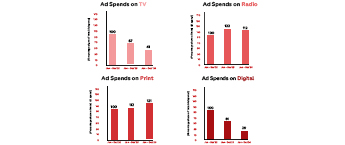2024 Advertising Trends in Fashion & Apparel: TV, Print, Radio & Digital Insights


2024 Advertising Trends in Fashion & Apparel: TV, Print, Radio & Digital Insights
1. Introduction: The Changing Landscape of Fashion Advertising (2022-2024)

The fashion and apparel industry has seen big changes in advertising over the past three years. As customer habits change, brands are adjusting their spending on TV, print, radio, and digital ads to stay competitive. Understanding these trends is key to getting the best value for ad budgets, tracking how luxury and fast fashion brands are shifting their strategies, and finding the right mix of traditional and digital ads for better reach.
The 2022-2024 report found that TV ad spend dropped by 59% as brands moved towards print and digital. Print ads grew by 21%, especially for luxury and regional brands, while radio advertising increased by 12%, mainly for regional fashion retailers. Surprisingly, digital ad spend fell by 71% due to market saturation and rising costs. The biggest ad spending seasons were during festivals, sports events, and end-of-season sales.
2. The Evolution of Advertising in Fashion & Apparel
The lifestyle and apparel industry has changed how it spends on ads between 2022 and 2024. TV ads dropped by 59% as brands looked for cheaper options like digital and print. Print ads grew by 21%, mainly because luxury brands used them to reach select audiences. Radio ads also increased by 12%, especially in smaller cities and regional markets. Surprisingly, digital ads fell by 71% due to higher costs, privacy rules, and too many brands competing for space. As brands rethink their strategies, a balanced mix of traditional and digital advertising is becoming key. Understanding these trends helps businesses invest wisely and reach the right audience. The shift shows that consumer behavior is constantly evolving, and brands must adapt to stay ahead.
3. Television Advertising Trends: Still Relevant in the Digital Age?
Despite a decline in TV ad budgets, fashion brands continue to invest in prime-time advertising. In 2024, Myntra Designs led with a 35% TV ad share, maintaining its top position, followed by Reliance Retail at 15%. Pothys moved up to third place with 8%, while Kalyan Silk Sarees climbed from ninth to fourth with 5%.
General Entertainment Channels (GECs) dominated TV ad spends with a 51% share, attracting family audiences, while News & Movie Channels accounted for 39%, appealing to professionals and leisure viewers. Prime time (6 PM - 11 PM) remained the most valuable slot, with 48% of fashion ads airing during this period, and weekends seeing the highest ad frequency.
4. Print Media Advertising: The Unexpected Comeback
Print media is evolving in 2024, luxury brands and regional retailers increased their print ad spending by 21%, leveraging newspapers to target affluent and local audiences. The South Zone led with 37% of total print ads, focusing on cities like Chennai, Hyderabad, and Bangalore, followed by the North Zone at 31% with Delhi, Jaipur, and Chandigarh as key markets. The West Zone accounted for 15%, covering Mumbai, Pune, and Ahmedabad. Leading publications such as Times of India, Hindustan, Dainik Bhaskar, and The Hindu dominated apparel advertising, reinforcing the credibility and reach of print media.
5. Radio Advertising: The Power of Local & Regional Reach
Radio ad spending grew by 12% in 2024, making it a key channel for regional apparel brands. Radio Mirchi led the market with 35% of apparel ads, while My FM (11%) and Red FM (10%) gained traction in tier-2 and tier-3 cities. The biggest spikes in radio advertising occurred during festivals and wedding seasons, with brands heavily promoting ethnic and luxury wear. Additionally, End-of-Season Sales (EOSS) saw a surge in radio ads as brands pushed mass-market fashion to attract budget-conscious shoppers.
6. Digital Advertising Trends: A 71% Decline—Why?
Digital ad spending saw a decline in 2024 due to several factors. Market saturation has led to intense competition among brands, making it harder to capture consumer attention. Additionally, rising ad costs on platforms like Facebook and YouTube have made digital advertising more expensive. Stricter privacy laws have also impacted retargeting capabilities, limiting brands' ability to reach their audience effectively. Despite these challenges, Nykaa e-Retail (22%), Reliance Retail (16%), and Myntra Designs (9%) remained the top digital advertisers.
Promotions played a significant role in fashion advertising throughout 2024. Sales promotions dominated print advertising, accounting for 63% of total ad spends, while 43% of all promotions were discount-driven, catering to price-sensitive shoppers. Brands increasingly used multiple promotions, such as "Buy One Get One" (BOGO) combined with discounts, to attract consumers. Combination promotions, like bundled deals, also gained popularity as brands looked for innovative ways to boost sales.
Final thoughts
To stay ahead in fashion advertising, brands must invest in a balanced mix of traditional and digital media for maximum engagement. Leveraging influencer marketing and celebrity endorsements can significantly boost ROI, while data-driven strategies—such as AI-powered personalization and short-form video ads—will shape 2025 trends. As the industry evolves, brands need to rethink their ad spend allocation, focusing on cost efficiency, audience engagement, and conversion. Those who adapt to these shifts will lead the competitive apparel market in the coming years.
FAQs
It depends on your target audience and budget. TV is great for mass reach, print works well for luxury brands, radio is ideal for regional marketing, and digital is best for personalized, performance-driven campaigns.
Digital ad spend has declined due to rising ad costs, market saturation, and stricter privacy regulations. Brands are now adopting multi-channel strategies instead of relying solely on digital.
Celebrity endorsements are highly effective for boosting brand credibility and engagement. Brands should align with celebrities or influencers who resonate with their audience and integrate them across TV, social media, and digital ads
Yes! Print media saw a 21% growth in 2024, especially among luxury and premium apparel brands. Regional newspapers and fashion magazines remain high-trust platforms for targeted advertising.
At Excellent Publicity, we provide customized, data-driven ad solutions across TV, print, radio, and digital platforms. Our strategic campaigns ensure maximum brand visibility, engagement, and sales growth.

